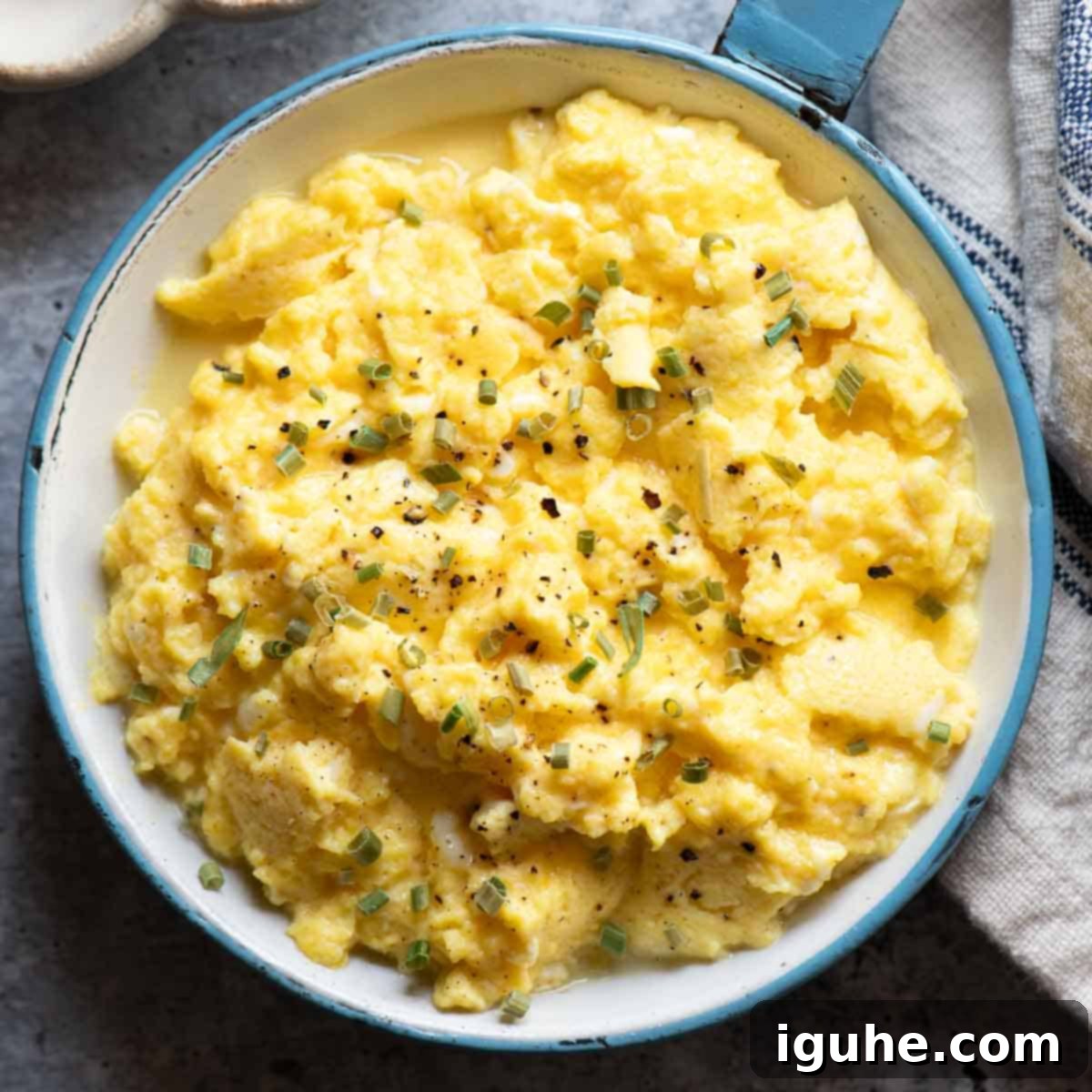Unlock the Secret to Unbelievably Fluffy & Tangy Buttermilk Scrambled Eggs
Buttermilk Scrambled Eggs are a truly delicious and surprisingly simple twist on the classic breakfast staple, offering an unparalleled rich, tangy flavor and an ultra-creamy, incredibly tender texture. If you thought you knew scrambled eggs, prepare to have your breakfast world transformed. This recipe elevates everyday eggs into a gourmet experience that’s both easy to achieve and deeply satisfying. Whether you serve them on their own for a quick, comforting meal, nestled on a slice of buttery toast, or as a decadent side alongside crispy bacon or savory sausage, these buttermilk-infused scrambled eggs are a simple yet profoundly flavorful way to upgrade your morning routine.
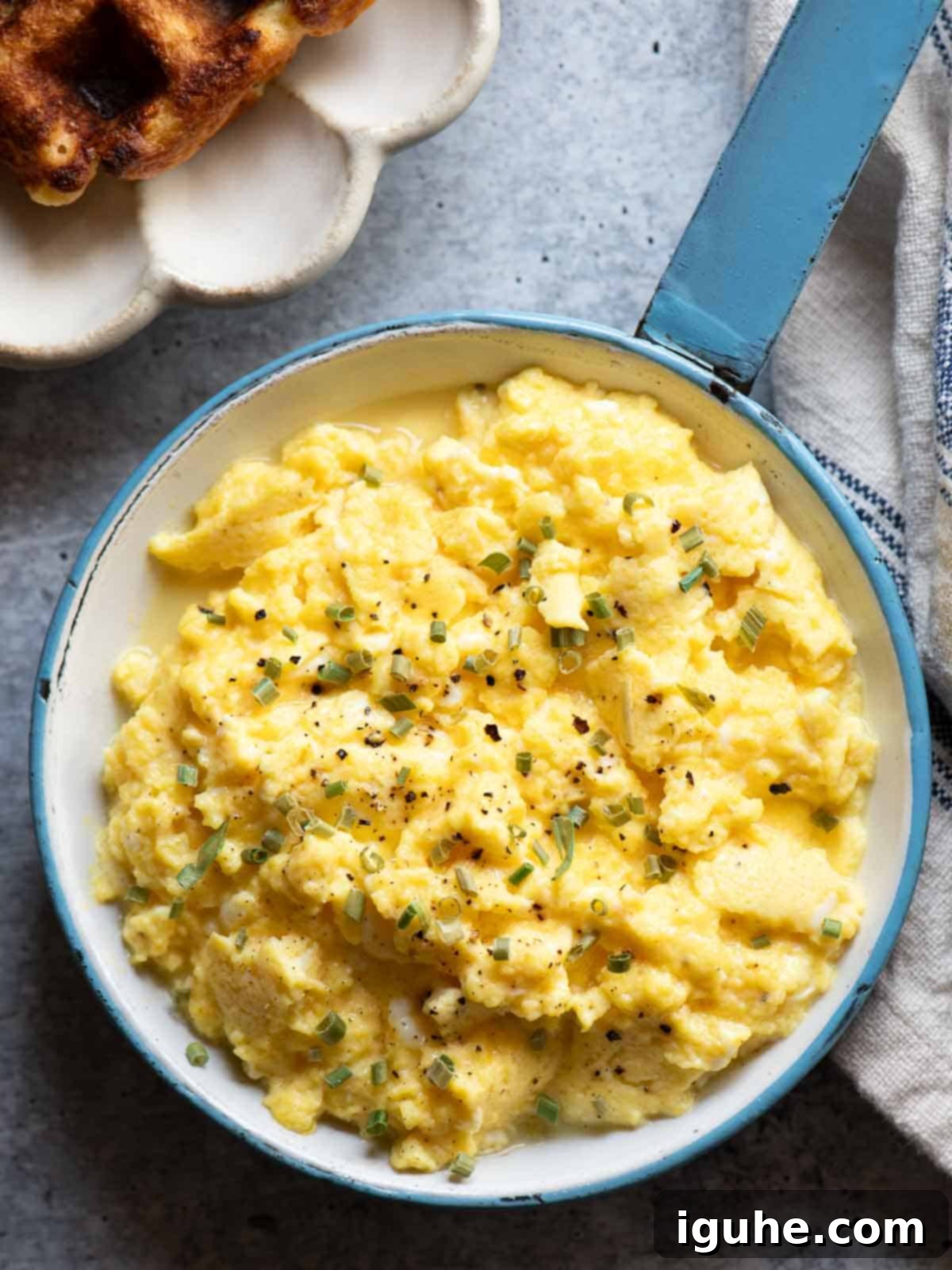
My kitchen has a long-standing love affair with buttermilk. It’s an ingredient I frequently turn to for my baked goods, lending an irresistible tenderness and subtle tang to everything from muffins to breads. Lately, I’ve discovered a new, ingenious use for that leftover buttermilk in my fridge: transforming my morning “scramblies” (yes, that’s our affectionate family term for scrambled eggs).
The magic of buttermilk in scrambled eggs lies in its unique properties. Its slight acidity works wonders, enhancing the natural richness of the eggs while simultaneously keeping them incredibly light and fluffy. This is due to the lactic acid in buttermilk, which gently breaks down the protein in the eggs, preventing them from becoming tough or rubbery. When cooked gently over low heat, as this recipe instructs, the result is consistently soft, velvety, and perfectly tender eggs every single time! No more dry, overcooked eggs – just a luscious, custardy texture that will make you rethink your breakfast game.
Adding buttermilk isn’t just about texture; it also imparts a delightful, subtle tang that complements the savory notes of the eggs. It’s a flavor profile that’s more complex and intriguing than plain scrambled eggs, yet still familiar and comforting. This simple addition makes a world of difference, turning an ordinary dish into something truly special. Get ready to impress your family and friends with this elevated breakfast classic.
[feast_advanced_jump_to]
What You Will Need for the Best Buttermilk Scrambled Eggs
You’ll be delighted to know that achieving these gourmet-level scrambled eggs requires only a handful of common ingredients. With just 5 easy items, you’re well on your way to starting your day with a truly exceptional breakfast. The beauty of this recipe lies in its simplicity, allowing the quality of each ingredient to shine through and create a harmonious, delicious plate.
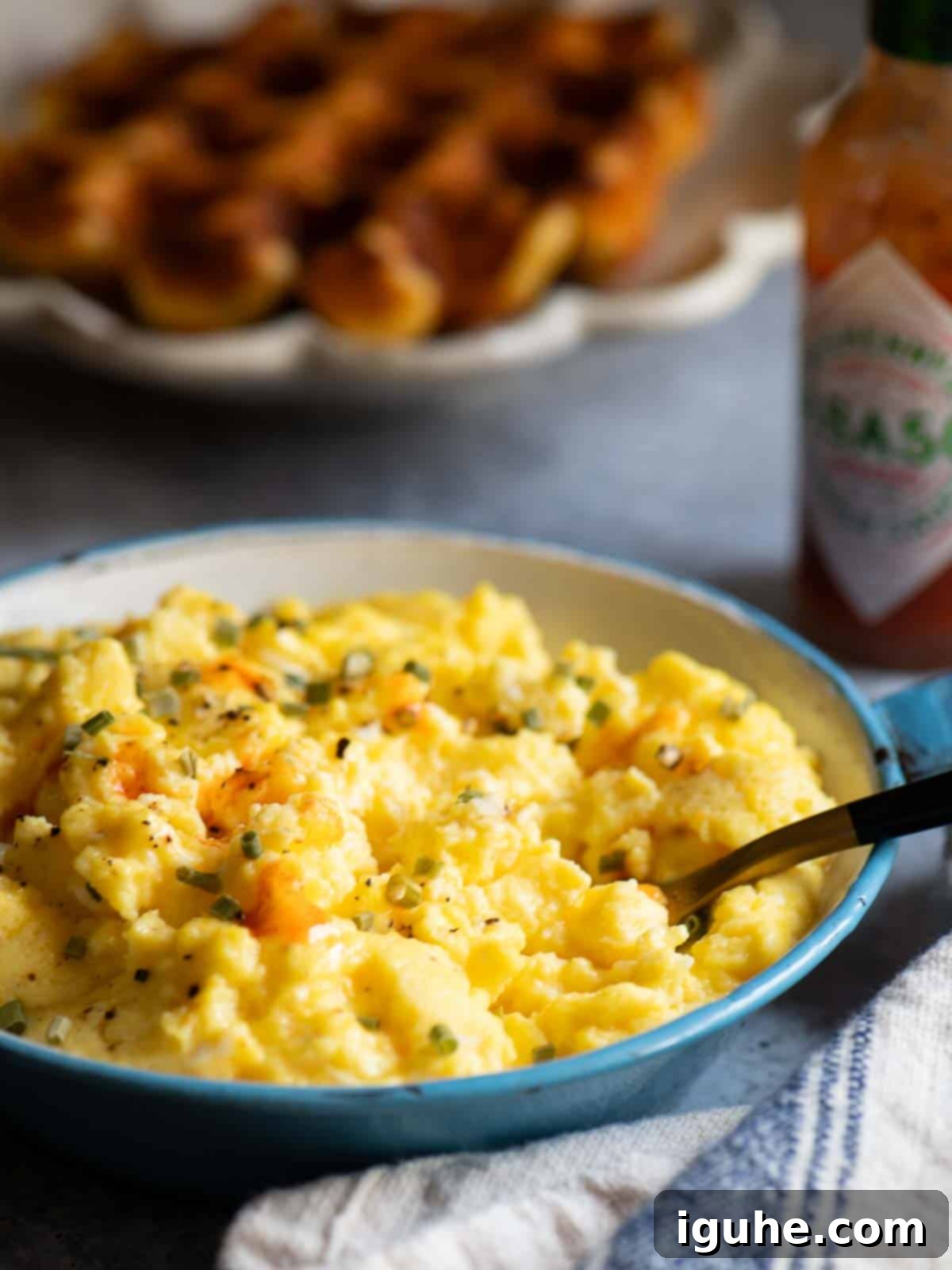
- Eggs: The fresher, the better! Use large, high-quality eggs for the best flavor and texture. Free-range or organic eggs often yield a richer yolk and better taste.
- Buttermilk: This is the star ingredient! While there are various ways to create buttermilk substitutes for baked goods (like adding lemon juice or vinegar to milk), I strongly recommend using real, cultured buttermilk here. The authentic product provides the specific tanginess, viscosity, and acidic properties needed to achieve the signature creamy, fluffy texture of these scrambled eggs. It won’t yield the same, perfect result with substitutes. If you don’t have it on hand, wait until you have leftovers from another recipe. I promise, the authentic buttermilk experience will be absolutely worth it!
- Salt and Pepper: Essential for seasoning. I typically use fine sea salt or Kosher salt and freshly ground black pepper to taste. These basic seasonings enhance the natural flavors of the eggs and buttermilk.
- Butter: Crucial for cooking the eggs and contributing to their rich flavor. I always opt for unsalted butter, as it allows me to control the salt content precisely. If you’re using salted butter, remember to omit or significantly reduce the amount of salt added to the egg mixture to avoid over-seasoning.
- Fresh Herbs (such as chives or scallions) and Hot Sauce: These are entirely optional but highly recommended for serving. A sprinkle of fresh, vibrant herbs like finely chopped chives or scallions adds a burst of fresh flavor and color. A dash of your favorite hot sauce (like Tabasco) can provide a welcome kick of heat, complementing the tangy eggs beautifully.
How to Make Perfect Buttermilk Scrambled Eggs: Step-by-Step Guide
Crafting creamy, fluffy scrambled eggs with buttermilk is a straightforward process. Here is a quick overview of how to achieve this delicious breakfast treat, ensuring a tender, tangy result every time. Remember, the key is low and slow cooking!
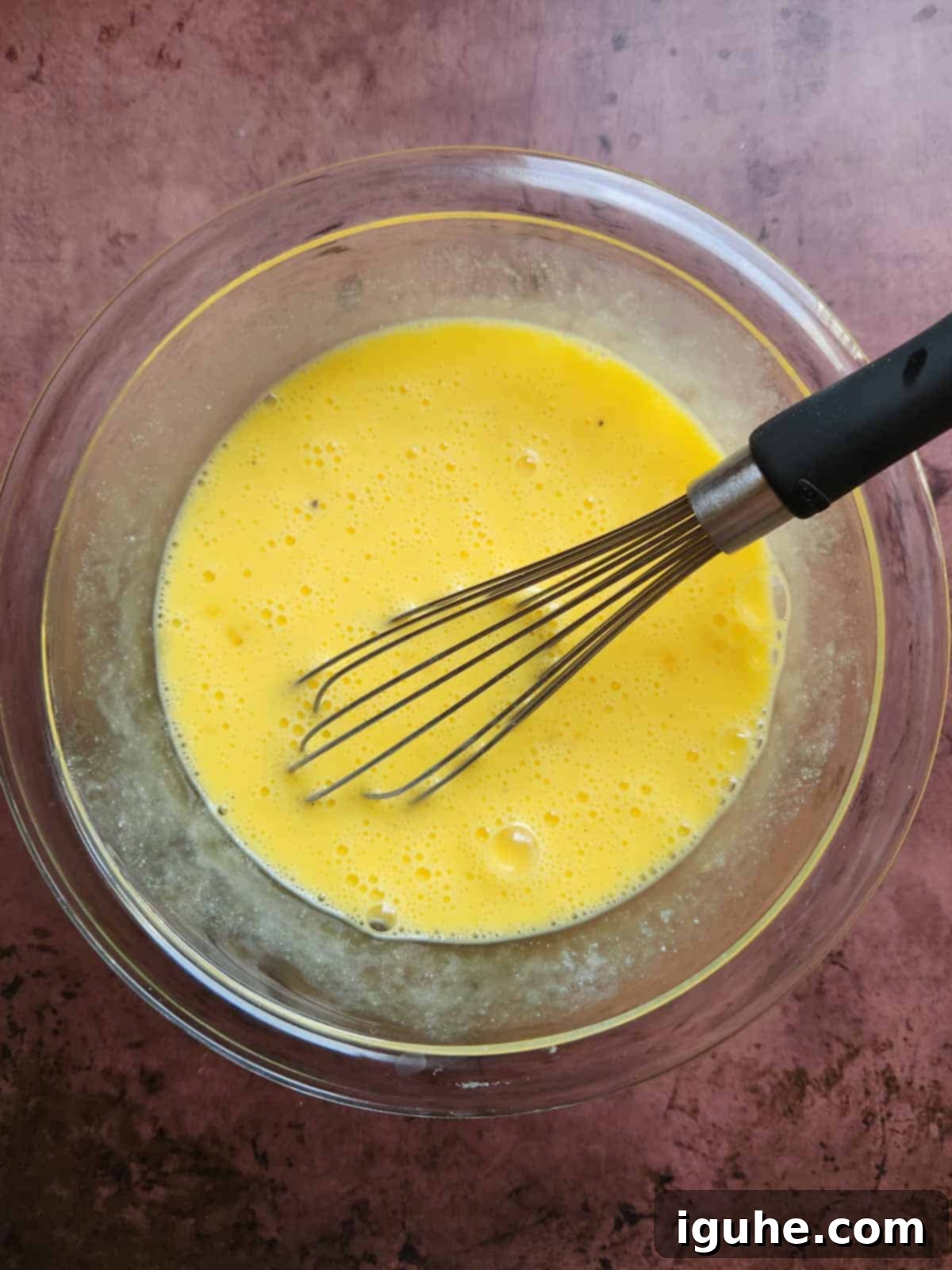
Step 1: Prepare the Egg Mixture. In a large mixing bowl, combine the fresh eggs, creamy buttermilk, a pinch of salt, and a dash of black pepper. Whisk these ingredients together until the yolks and whites are fully combined and the mixture is light and slightly foamy. Don’t over-whisk, as this can incorporate too much air and lead to a drier texture; aim for just enough to combine the ingredients evenly.
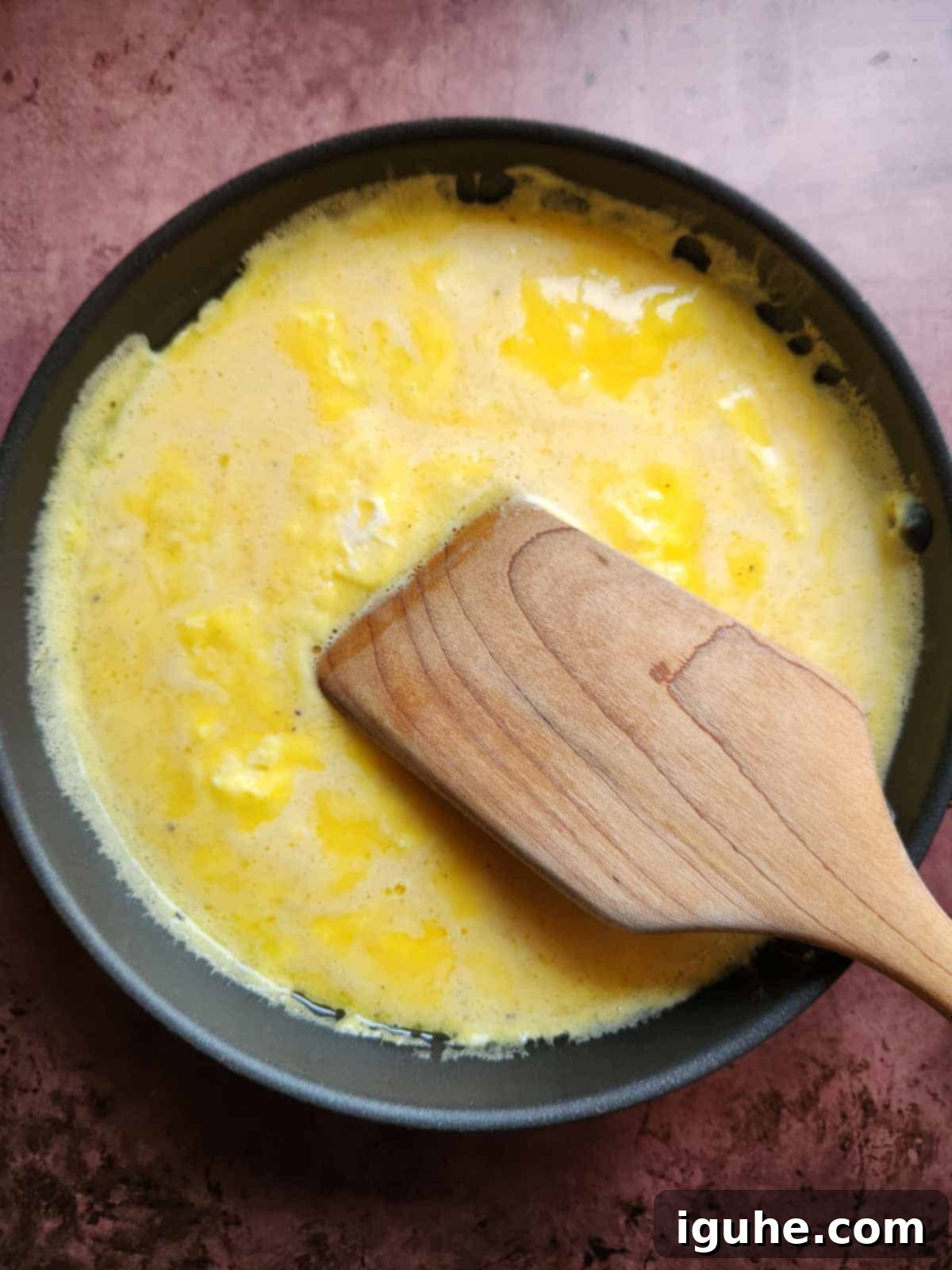
Step 2: Gentle Cooking Begins. Melt the butter in a medium-sized non-stick pan over medium-low heat. The key here is to keep the heat gentle; you don’t want to brown the butter. Once the butter is fully melted and just beginning to foam slightly, pour in the whisked egg and buttermilk mixture. Immediately, using a heat-resistant spatula or a wooden spoon, begin to slowly and gently move the eggs from side to side in big, sweeping strokes across the pan. This slow movement helps create those coveted large, soft curds.
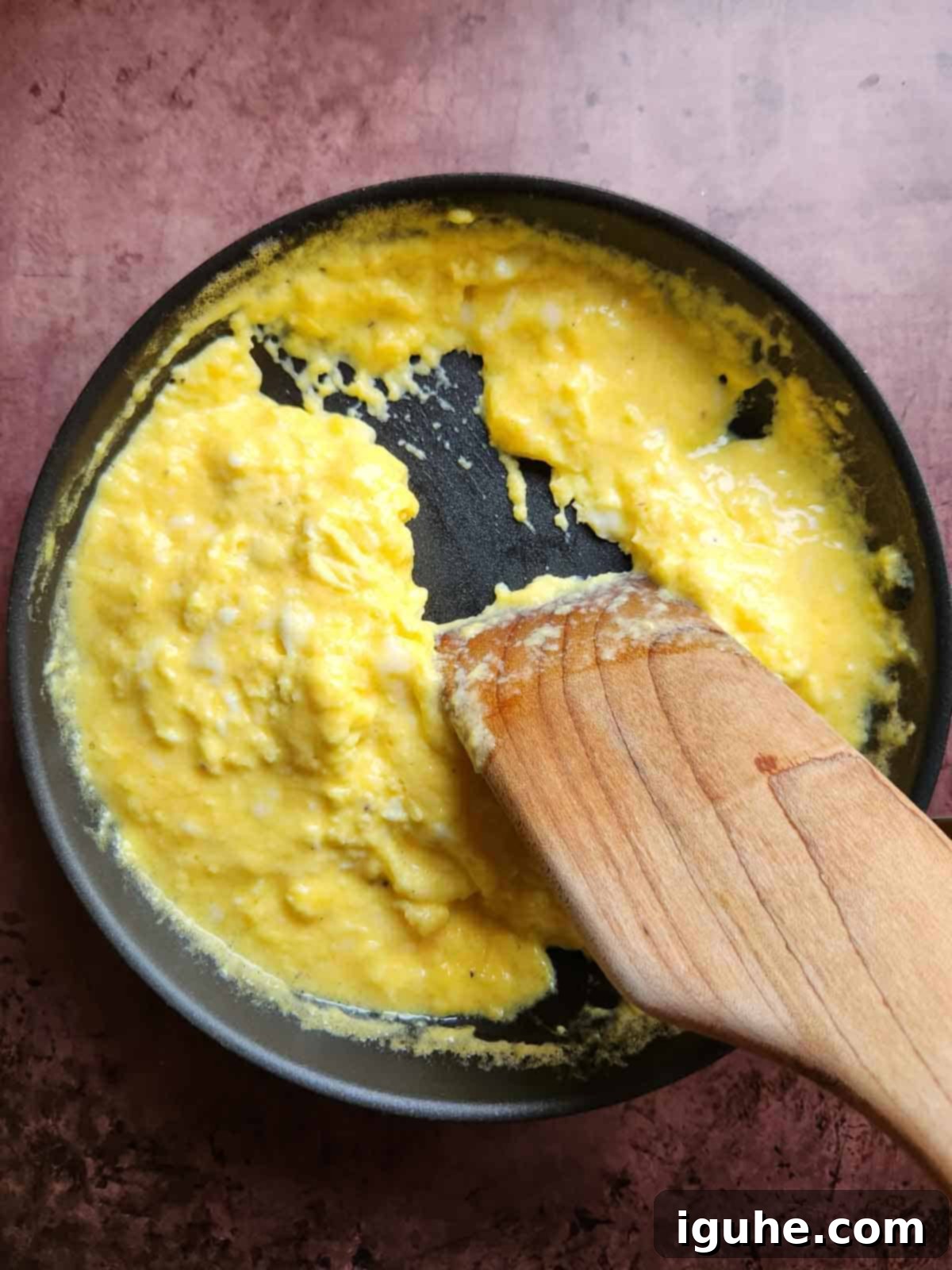
Step 3: Forming the Curds. Continue this gentle, continuous motion, moving the eggs across the pan. As they warm, the eggs will slowly begin to coagulate and form large, soft curds. This process should not be rushed. If you notice them cooking too quickly, reduce the heat to low. The goal is to cook them until they are just set, still appearing moist and creamy with a few traces of liquid remaining.
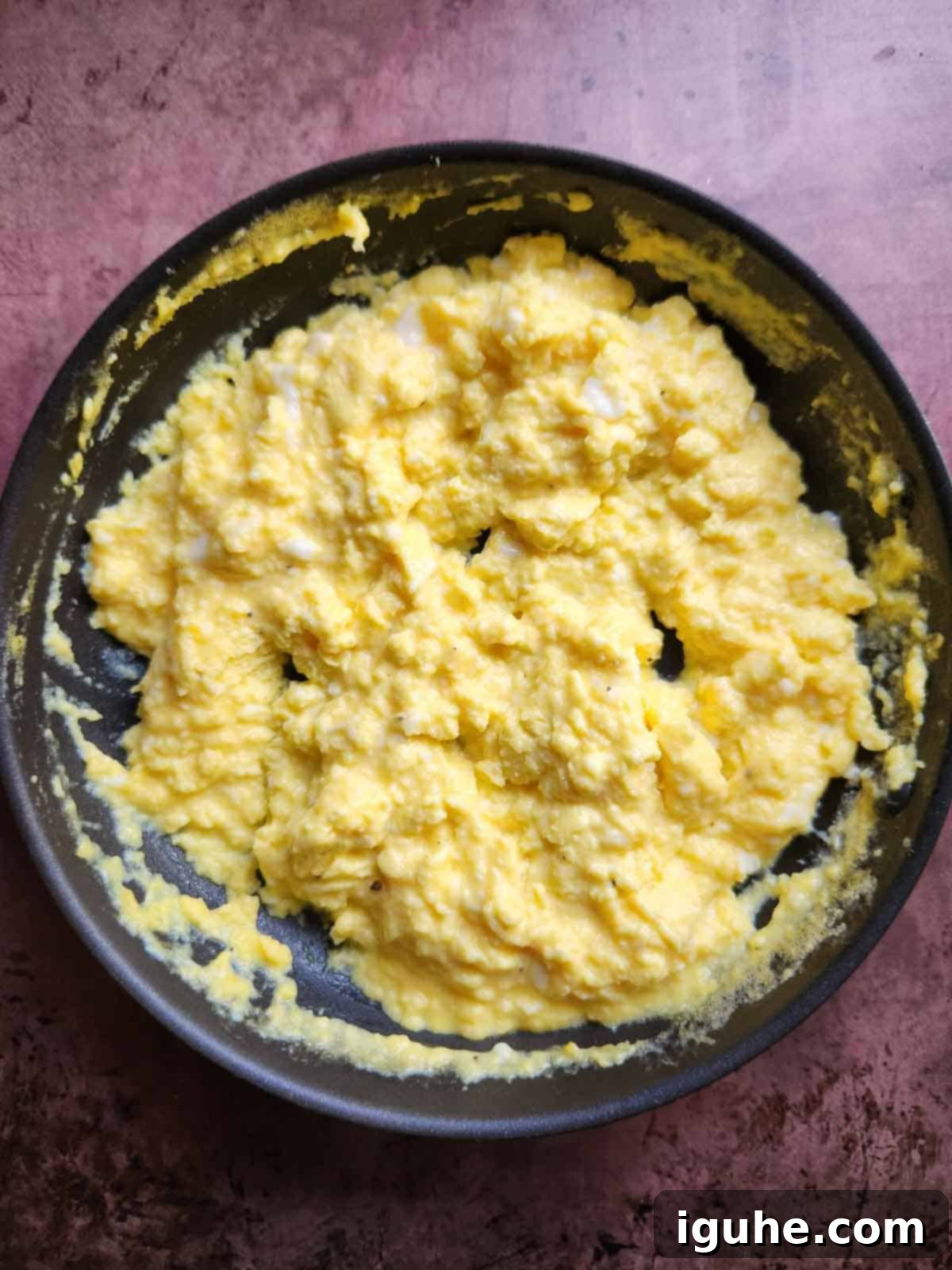
Step 4: The Finishing Touch. Once the eggs are *just* set, remove the pan from the heat. Give them one final stir. Remember, the residual heat from the pan will continue to cook the eggs for a short period, so it’s better to undercook them slightly than to overcook. This ensures they remain incredibly soft and custardy, rather than becoming dry and firm. If you prefer your eggs more well-done, continue cooking on very low heat for another minute or so until they reach your desired consistency.
Serve your perfect Buttermilk Scrambled Eggs immediately! Garnish with a sprinkle of fresh herbs like chives or scallions, a dash of your favorite hot sauce, or whatever delightful toppings you love to pair with your scrambled eggs. Enjoy the rich, tangy, and impossibly creamy goodness!
👩🍳Expert Tips for Flawless Buttermilk Scrambled Eggs
Achieving restaurant-quality scrambled eggs isn’t difficult when you know a few tricks. These expert tips will help ensure your buttermilk scrambled eggs are consistently perfect:
The golden rule for the best scrambled eggs, especially with buttermilk, is to cook them low and slow. Keep the heat between medium-low to low, patiently stirring with a spatula or wooden spoon. This gentle approach creates those signature soft, fluffy, and moist curds. Avoid high heat at all costs, as it leads to dry, rubbery eggs. Patience is key for perfection!
- Use a Non-Stick Pan: This is non-negotiable for easy cooking and cleanup. A good non-stick pan will prevent the eggs from sticking and browning too much.
- Don’t Skimp on the Butter: Butter adds incredible flavor and helps create that luxurious, creamy texture. If you’re concerned about calories, you can slightly reduce it, but it truly makes a difference.
- Whisk Just Enough: You want the yolks and whites fully combined, and the buttermilk integrated. Over-whisking can introduce too much air, leading to a lighter but sometimes less custardy texture. A few dozen brisk whisks should do the trick.
- Remove from Heat Early: As mentioned in the instructions, eggs continue to cook even after they’re off the heat. Remove them when they still look slightly underdone and moist. They’ll finish cooking perfectly as you transfer them to plates.
- Serve Immediately: Scrambled eggs are best enjoyed fresh off the stove. Their delicate texture and warmth are at their peak right after cooking.
- Fresh Ingredients Matter: High-quality eggs and fresh, real buttermilk will yield superior results in both flavor and texture. This simple recipe highlights the quality of its core ingredients.
- Don’t Overcrowd the Pan: If you’re making a larger batch, consider cooking in two smaller batches to ensure even cooking and prevent the pan from cooling down too much.
Creative Ways to Customize Your Buttermilk Scrambled Eggs
While these buttermilk scrambled eggs are fantastic on their own, they also provide a superb canvas for customization. You can easily elevate and personalize your dish with a few simple additions. Which one will you choose to make your breakfast uniquely yours?
- Sour Cream or Crème Fraîche: For a similar tanginess and an even richer creaminess, sour cream or crème fraîche can be used in place of, or in addition to, the buttermilk. Stir it in when the eggs are just about done cooking to prevent it from curdling.
- Add Cheese for Extra Indulgence: Cheese and eggs are a match made in heaven! Shredded cheddar, creamy gouda, nutty gruyère, or sharp Parmesan can be folded into the eggs when they are just about finished cooking. The residual heat will melt the cheese into gooey perfection, adding another layer of flavor and richness.
- Experiment with Different Herbs: Beyond chives and scallions, explore other aromatic herbs. Try fresh dill for a bright, slightly citrusy note, or delicate tarragon for a subtle anise flavor. Parsley or cilantro can also be fantastic additions.
- Bring the Heat with Spices and Sauces: If you love a bit of a kick, there are many ways to add heat. Stir in a teaspoon of chili crisp for a savory, spicy, and textural element. A spoonful of store-bought salsa or a dash of your favorite hot sauce (beyond just Tabasco) can also provide a fresh, zesty heat. Minced jalapeños or a pinch of red pepper flakes can also be folded in during cooking.
- Sautéed Vegetables: Lightly sautéed spinach, mushrooms, bell peppers, or onions can be folded into the eggs towards the end of cooking for added nutrition and flavor.
- Spices: A tiny pinch of smoked paprika can add a subtle depth, or a touch of garlic powder can enhance savoriness. Be careful not to overpower the delicate egg flavor.
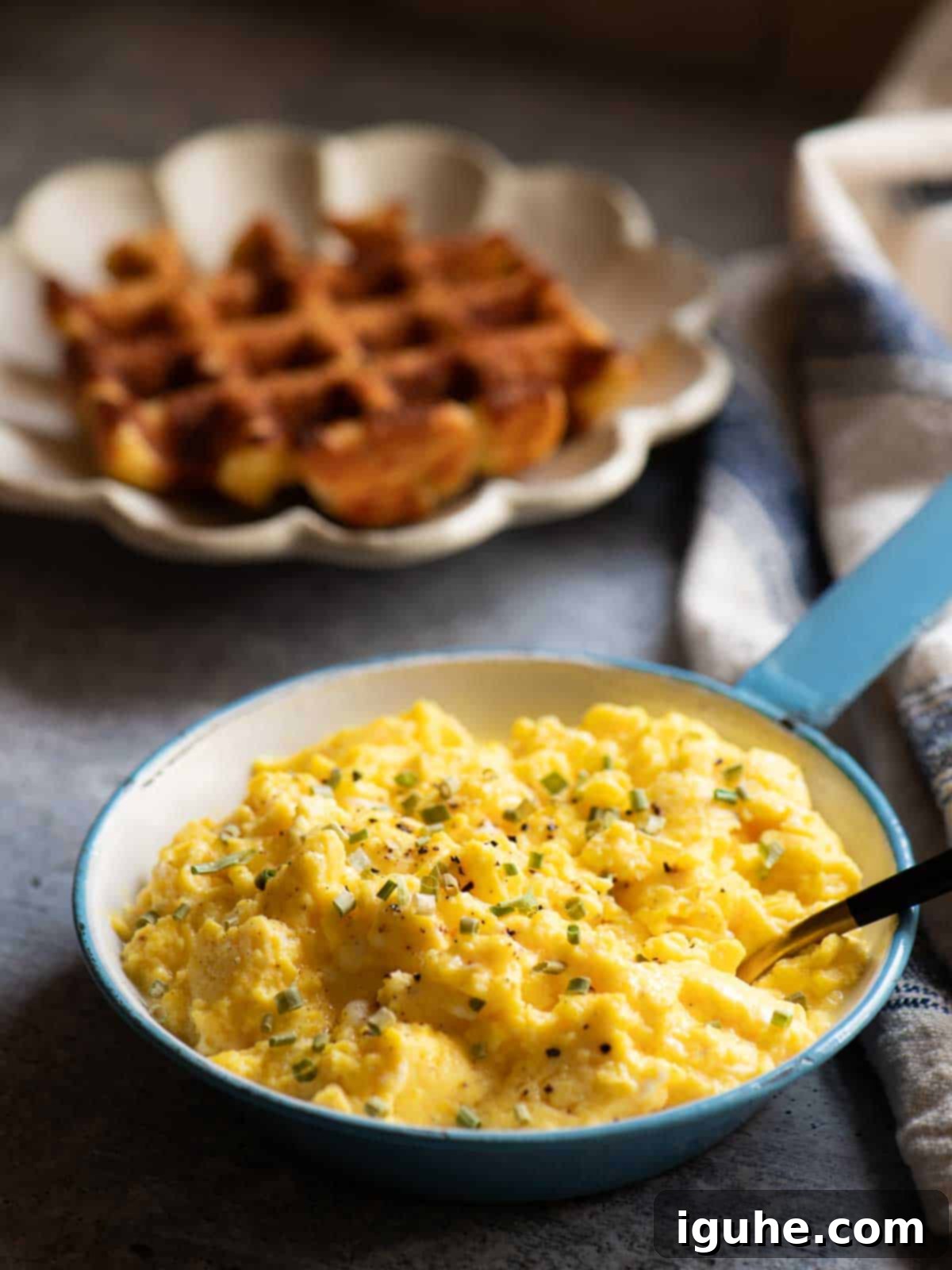
Serving Suggestions: What to Pair with Buttermilk Scrambled Eggs
Buttermilk scrambled eggs are incredibly versatile. They can be the star of your breakfast plate, or a delightful side dish to a larger meal. Eat them plain to savor their unique flavor, or load them with your favorite toppings for an extra burst of deliciousness. Don’t forget to add warm, buttered toast – a classic pairing – or a simple side salad for a refreshing, complete meal. Here are a few ways to top your “scramblies” and turn them into a culinary masterpiece:
- Avocado: Sliced, diced, or mashed, fresh avocado adds a creamy, healthy fat that contrasts beautifully with the tangy eggs. A sprinkle of flaky sea salt on top of the avocado is a must!
- Sautéed Mushrooms: Earthy, umami-rich sautéed mushrooms (cremini, shiitake, or a wild mushroom mix) add depth and a satisfying texture. Cook them in butter with a touch of garlic for maximum flavor.
- Smoked Salmon: For a touch of elegance and a burst of salty, briny flavor, drape thin slices of smoked salmon over your warm eggs. A sprinkle of fresh dill often accompanies this pairing perfectly.
- Bacon Jam: If you’re feeling adventurous and want to experience a truly gourmet breakfast, a spoonful of sweet and salty bacon jam offers an incredible flavor contrast and a luxurious texture.
- Cherry Tomatoes: Whether lightly confit, oven-roasted until bursting, or simply halved fresh, cherry tomatoes add a juicy pop of sweetness and acidity that brightens the entire dish.
- Caramelized Onions: Slow-cooked, sweet, and sticky caramelized onions are a fantastic savory addition, adding a profound depth of flavor.
- Crispy Fried Onions or Shallots: For texture and a savory crunch, sprinkle some crispy fried onions or shallots on top.
- Everything Bagel Seasoning: A quick and easy way to add a burst of savory, garlicky, and oniony flavor with a satisfying crunch.
Storage & Reheating Tips for Buttermilk Scrambled Eggs
While scrambled eggs are undeniably at their absolute best when eaten fresh, right off the stove, you can certainly store leftovers if you happen to have any. Place any cooled leftover buttermilk scrambled eggs in an airtight container and refrigerate them for up to 3 days.
When it comes to reheating, a gentle approach is key to maintaining their delicate texture. I usually warm them gently in the microwave in short bursts (30-60 seconds at a time), stirring in between, until just heated through. Be careful not to overheat, as this can make them dry and rubbery. Alternatively, you can reheat them in a non-stick pan over very low heat, adding a tiny splash of milk or even a knob of butter to help restore some moisture and creaminess.
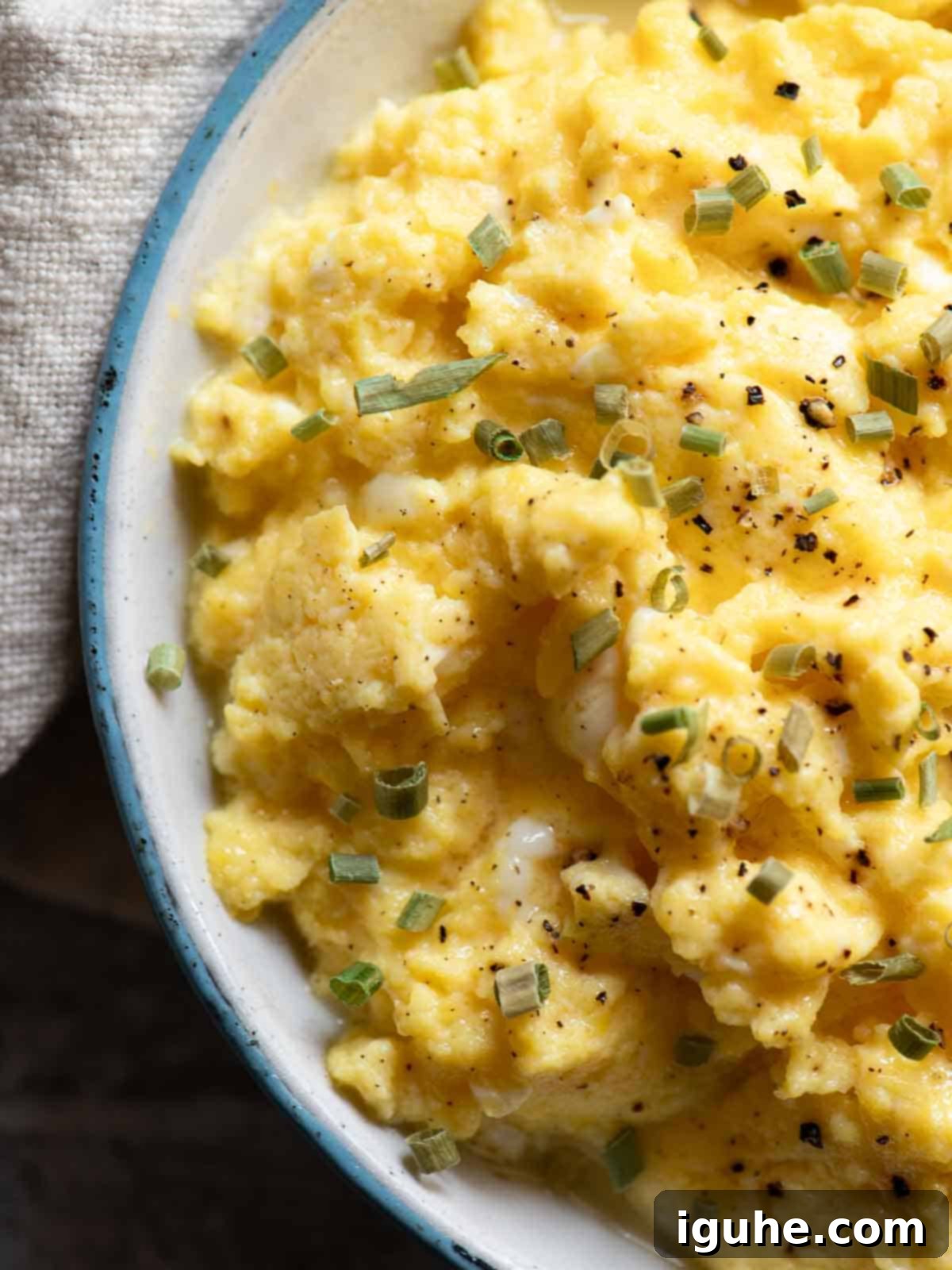
Frequently Asked Questions About Buttermilk Scrambled Eggs
While buttermilk powder or homemade substitutions (like adding lemon juice or vinegar to regular milk) can be adequate for some baking recipes, I strongly advise against using them for these scrambled eggs. The primary reason is that this recipe relies on very few ingredients – essentially just eggs and buttermilk – and you want the authentic tanginess, specific consistency, and unique acidic properties of real, cultured buttermilk to truly shine through. Substitutes simply won’t yield the same delicate, custardy texture and distinct flavor that makes these buttermilk scrambled eggs so exceptional. For the best results, use the real deal!
A good quality non-stick pan is absolutely essential for making perfect scrambled eggs. It prevents the eggs from sticking to the bottom and allows them to cook evenly without forming a crust. This also makes the gentle stirring process much easier and ensures that your curds remain soft and intact. Look for a pan that heats evenly.
Cooking scrambled eggs over low to medium-low heat is the secret to achieving that incredibly soft, creamy, and custardy texture. High heat cooks the eggs too quickly, causing the proteins to tighten and become rubbery and dry. Slow cooking allows the eggs to gently set, creating delicate curds and retaining moisture, which is especially enhanced by the buttermilk.
Absolutely! Adding vegetables or cheese is a fantastic way to customize your buttermilk scrambled eggs. For vegetables, it’s best to sauté them lightly beforehand until tender, then fold them into the egg mixture just before cooking, or stir them in during the last minute of cooking the eggs. For cheese, fold in shredded or crumbled cheese when the eggs are about 70-80% cooked. The residual heat will melt the cheese beautifully, creating a rich, gooey addition without overcooking the eggs.
While fresh herbs offer the best flavor and visual appeal, you can certainly skip them if you don’t have any on hand. The eggs will still be delicious! If you only have dried herbs, use them sparingly, as their flavor is much more concentrated. A tiny pinch of dried chives or a very light sprinkle of dried parsley could work, but fresh is definitely preferred for this dish.
Did Someone Say Buttermilk? Explore More Delicious Buttermilk Recipes!
My passion for buttermilk extends far beyond just scrambled eggs. It’s truly a versatile ingredient that can elevate both sweet and savory dishes, lending a unique tenderness and subtle tang. If you’re now a buttermilk convert, or simply looking for more ways to use up that carton in your fridge, check out some of my other favorite recipes featuring this incredible ingredient. From fluffy waffles to moist muffins, there’s a buttermilk delight waiting for you!
- Green Chili Cheddar Waffles
- Pistachio Muffins with Chocolate Chips
- Brown Sugar Pancakes
- Irish Soda Bread with Currants and Apricots
Did you make this recipe? I would love to hear about it! Please leave a ⭐⭐⭐⭐⭐ rating with a comment right below the recipe card. If you snap a photo of your creation, don’t forget to tag me on Instagram @brunchandbatter.
📖Recipe: Creamy Buttermilk Scrambled Eggs
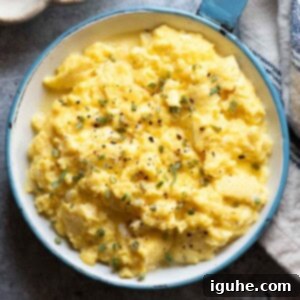
Buttermilk Scrambled Eggs
Pin Recipe
Equipment
-
non-stick pan
-
spatula or wooden spoon
Ingredients
- 6 large eggs
- ¼ cup buttermilk
- ¼ teaspoon Kosher or fine sea salt
- ⅛ teaspoon freshly ground black pepper
- 1 tablespoon unsalted butter for cooking the eggs omit salt if using salted butter
- chopped fresh chives or scallions for topping optional
- hot sauce (such as Tabasco) for seasoning optional
Instructions
-
In a medium bowl, whisk together the eggs, buttermilk, salt, and pepper until well combined.6 large eggs, ¼ cup buttermilk, ¼ teaspoon Kosher or fine sea salt, ⅛ teaspoon freshly ground black pepper
-
Heat a medium-sized non-stick pan over medium-low to low heat. Add the butter and let it melt until it starts to foam gently.1 tablespoon unsalted butter for cooking the eggs
-
When the butter is foaming, pour the egg mixture into the pan. Immediately, using a heat-resistant spatula or wooden spoon, gently push the eggs from side to side across the pan, creating soft curds. Continue to slowly and continuously move the spatula in all directions until the eggs begin to set but still appear moist. Adjust the heat to low if they are cooking too fast. When the eggs are just about set, with a few traces of liquid still visible, remove the pan from the heat (the residual heat from the pan will continue to cook the eggs to perfection). For well-done eggs, continue cooking on low heat until your desired doneness is reached.
-
Serve immediately, garnished with fresh herbs and/or hot sauce, if desired, for an extra burst of flavor.chopped fresh chives or scallions for topping, hot sauce (such as Tabasco) for seasoning
Notes
- Avoid using buttermilk substitutes here (buttermilk powder or lemon/vinegar milk combinations), as the consistency and taste will not be the same and will not yield the desired creamy texture.
- Always use a non-stick pan and cook over low heat for the best, most tender results.
- Serve immediately to enjoy the optimal flavor and texture of your buttermilk scrambled eggs.
Nutrition*
*Nutrition information is provided as a courtesy and is an estimate only. Nutrition information can vary depending on many factors, such as products used, measurements and substitutions, therefore it is recommended that you obtain nutritional calculations based on your own finished recipe.
